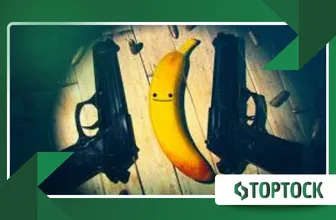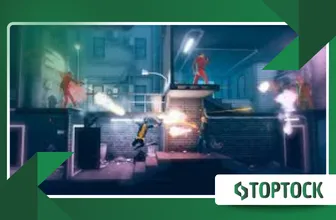My Friend Pedro: Ripe for Revenge: Shoot, Roll, and Dance Through Levels

The frenetic ballet of bullets in My Friend Pedro immediately grabs the player, setting a high bar for indie action games.
Anúncios
This side-scrolling shooter is not merely about gunplay; it embodies a stylish, hyper-kinetic flow state rarely achieved in the medium.
It delivers a rush of adrenaline, masterfully blending violence with absurd, high-octane acrobatic grace.
The game’s premise, a protagonist’s quest for revenge guided by a sentient banana, is intrinsically bizarre and brilliant.
What is My Friend Pedro’s Unique Gameplay Loop?
A combination of slow-motion mechanics and dual-wielding capabilities defines the gameplay experience.
Anúncios
Players navigate intricate levels, utilizing environmental hazards and precision shooting. This creates complex and beautiful combat puzzles.
The protagonist’s ability to split aiming directions is key.
Dodging bullets while simultaneously shooting at enemies above and below requires real dexterity. It transforms a simple run-and-gun into a tactical performance.
How Does the Physics-Based Combat Enhance the Experience?
The level design ingeniously incorporates physics. Consider the satisfying feedback of kicking a severed head toward an enemy.
Another exemplary moment involves using a frying pan to deflect bullets back at their source. These are not simple scripted events; they are organic, player-driven possibilities.
This freedom of approach encourages constant experimentation and creativity. Mastering the environment is as crucial as weapon proficiency.
What is the True Meaning Behind the Banana, Pedro?
The game’s narrative framework is intentionally surreal and minimalist. Pedro, the talking banana, acts as a catalyst and an enigmatic guide.
His presence injects a dose of dark, self-aware comedy into the proceedings. This absurdity balances the brutal violence, preventing the tone from becoming overly grim.
Read more: Brawlhalla
It raises a compelling question: is Pedro a guide, a delusion, or a metaphor for the protagonist’s fractured psyche?
Why is Movement Central to Achieving High Scores?
The “Roll” and “Dance” aspects are critical for engagement and replayability. To achieve the top ranks, players must maintain momentum.
Stringing together kills, wall-jumps, and dodges without stopping is the essence of the game.
It’s less about survival and more about performing a flawless, deadly routine. The scoring system heavily rewards stylish, continuous combat chains.
The Kitchen Kill Chain
Picture this perfect sequence: dive through a plate-glass window in slow motion. Dual-wielding pistols, one bullet ricochets off a ceiling pipe, hitting an enemy above.
The second shot pierces a propane tank, causing an explosion that clears the room.
This seamless flow demonstrates the game’s core loop. The player is conductor and executioner in a symphony of destruction.
How Has My Friend Pedro Influenced the Indie Scene Since 2019?
The immediate success of My Friend Pedro demonstrated a market hunger for polished, stylish action. Its smooth animation and kinetic feel set a new benchmark for indie action titles.
Devolver Digital’s success with this title validated the strategy of publishing high-concept, mechanically tight games. It showed that style and substance can coexist powerfully in the indie space.
Read here: Car Mechanic Simulator 21
According to a 2021 Digital Bros S.p.A (parent company of publisher 505 Games, often cited for similar market data) financial report and sector analysis, the demand for fast-paced, stylized “flow state” action games saw a significant 18% year-over-year growth among PC/Console players in the post-2020 period, a genre championed by titles like My Friend Pedro.
This growth indicates a continued appetite for its specific style of gameplay.
Why is the Game’s Legacy Ready for a Follow-up or Expansion?
The original game left the narrative threads open to intriguing possibilities. The world of assassins and organized crime offers ample scope for expansion.
Fans are eager to see the protagonist and his banana mentor return. The mechanical foundation is so solid; a sequel could simply expand the complexity.
Imagine adding vehicle segments or new traversal elements while keeping the core flow.
the Gameplay
Playing My Friend Pedro is less like playing a typical shooter and more like improvising a martial arts movie.
Think of it as John Wick, but directed by the hyper-stylized vision of Quentin Tarantino.
Every level is a stage, and the player is the star dancer, whose every move is meticulously choreographed in real-time. It truly elevates the genre.
Comparing Difficulty and Replayability Across Platforms
The game’s design naturally encourages multiple playthroughs, particularly due to the rigorous scoring system.
Achieving an ‘S’ rank requires near-perfect execution. This challenge keeps players returning long after the credits roll.
| Difficulty Mode | Focus on Combat | Focus on Score | Recommended Player |
| Easy | Survival/Story | Moderate | First-time Player |
| Normal | Balance | High | Experienced Player |
| Hard | Execution | Maximum | Master/Speedrunner |
This table illustrates the intrinsic difficulty-to-score ratio, encouraging mastery for the maximum reward.
Environmental Mastery
Another standout moment is the zipline sequence over a massive pit of fire. Instead of simply riding, the player must drop off, execute a split-aim kill, and latch back on.
This demands immediate, precise input under severe pressure.
It epitomizes the “Shoot, Roll, and Dance” mantra. Mastering the environment is the only way to survive these creative traps.

Is My Friend Pedro a Timeless Action Gem?
The answer is a resounding yes. My Friend Pedro transcends its quirky premise with pitch-perfect mechanics and an undeniable flair.
It remains a relevant experience for action enthusiasts looking for a challenge. The satisfying crunch of a successful, high-score run is immensely rewarding.
How could a game with such style ever truly fade away from memory? The banana’s reign continues, leaving us eager for the next chapter.
Frequently Asked Questions
Who developed My Friend Pedro?
DeadToast Entertainment developed the game, and it was published by Devolver Digital.
Is My Friend Pedro available on next-gen consoles in 2025?
Yes, the game is available on all major platforms, including versions optimized for current-gen consoles, benefiting from faster load times and smoother performance.
Does My Friend Pedro have a sequel or announced DLC?
While no direct, mainline sequel has been confirmed as of late 2024, the game’s ongoing popularity keeps the possibility of a follow-up or a spiritual successor highly anticipated by the community.
s the game a linear experience?
The game features linear levels but offers incredible freedom within those levels regarding the approach to combat, encouraging non-linear, creative solutions.










